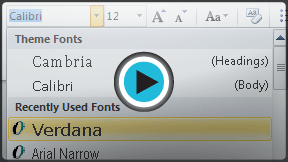
Word 2010
Formatting Text
Introduction

To create and design effective documents, you need to know how to format text. In addition to making your document more appealing, formatted text can draw the reader's attention to specific parts of the document and help communicate your message.
In this lesson, you'll learn to format the font size, style, and color; highlight the text; and use the Bold, Italic, Underline, and Change Case commands.
Formatting text
Formatted text can emphasize important information and help organize your document. In Word, you have many options for adjusting the font of your text, including size, color, and inserting special symbols. You can also adjust the alignment of the text to change how it is displayed on the page.
To change the font size:
- Select the text you wish to modify.
- Click the drop-down arrow next to the Font Size box on the Home tab. A drop-down menu appears.
- Select the desired font size from the menu. Alternatively, you can type the value that you want and then press Enter on your keyboard.
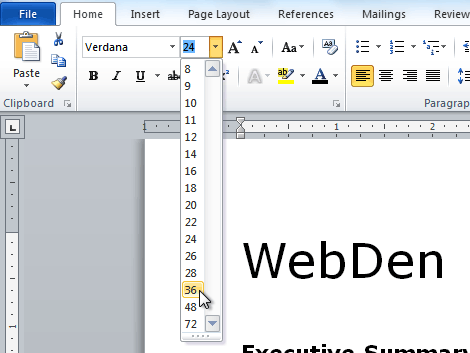 Changing the font size
Changing the font size
You can also use the Grow Font and Shrink Font commands to change the size.
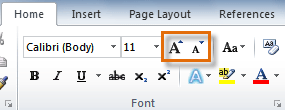 The Grow Font and Shrink Font commands
The Grow Font and Shrink Font commandsTo change the font:
- Select the text you wish to modify.
- Click the drop-down arrow next to the Font box on the Home tab. The Font drop-down menu appears.
- Move the mouse pointer over the various fonts. A live preview of the font will appear in the document.
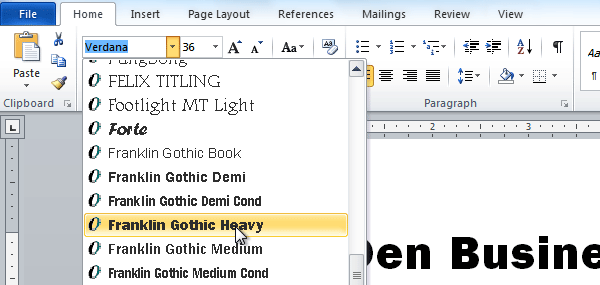 Changing the font
Changing the font - Select the font you wish to use. The font will change in the document.
To change the font color:
- Select the text you wish to modify.
- Click the Font Color drop-down arrow on the Home tab. The Font Color menu appears.
- Move the mouse pointer over the various font colors. A live preview of the color will appear in the document.
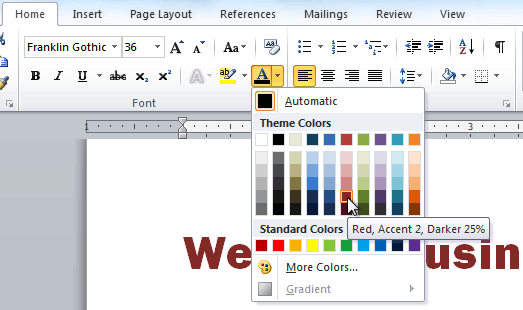 Changing the font color
Changing the font color - Select the font color you wish to use. The font color will change in the document.
Your color choices aren't limited to the drop-down menu that appears. Select More Colors at the bottom of the list to access the Colors dialog box. Choose the color that you want, then click OK.
To highlight text:
- From the Home tab, click the Text Highlight Color drop-down arrow. The Highlight Color menu appears.
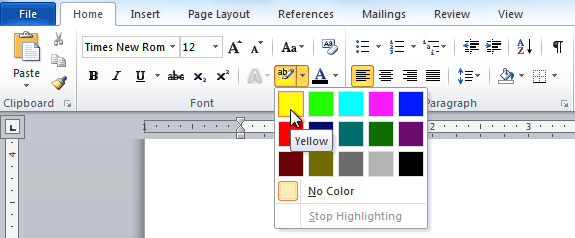 Choosing a highlight color
Choosing a highlight color - Select the desired highlight color.
- Select the text you wish to modify. It will then be highlighted.
 Highlighting text
Highlighting text - To switch back to the normal cursor, click the Text Highlight Color command.
To use the Bold, Italic, and Underline commands:
- Select the text you wish to modify.
- Click the Bold (B), Italic (I), or Underline (U) command in the Font group on the Home tab.
 Making text bold
Making text bold
To change the text case:
- Select the text you wish to modify.
- Click the Change Case command in the Font group on the Home tab.
- Select the desired case option from the list.
 Changing the text case
Changing the text case
To change the text alignment:
- Select the text you wish to modify.
- Select one of the four alignment options from the Paragraph group on the Home tab.
- Align Text Left: Aligns all selected text to the left margin.
- Center: Aligns text an equal distance from the left and right margins.
- Align Text Right: Aligns all selected text to the right margin.
- Justify: Justified text is equal on both sides and lines up equally to the right and left margins. Many newspapers and magazines use full justification.
 The four alignment options
The four alignment options
You can use Word's convenient Set as Default feature to save all of the formatting changes you've made and automatically apply them to new documents. To learn how to do this, read our article Changing Your Default Settings in Word.
Challenge!
- Open an existing Word document. If you want, you can use this example.
- Change the font size of some text.
- Change the font style of some text.
- Change the font color of some text.
- Try various cases using the Change Case command.
- Try the four alignment commands.
- Save the document.
